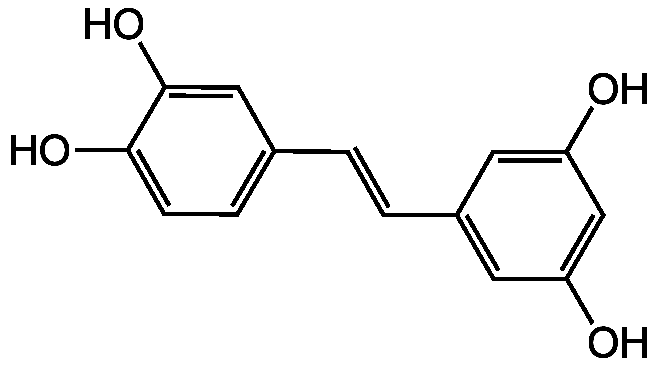
Chemical Structure
Piceatannol [10083-24-6]

AG-CN2-0086
Overview
- SupplierAdipoGen Life Sciences
- Product NamePiceatannol [10083-24-6]
- Delivery Days Customer10
- CAS Number10083-24-6
- CertificationResearch Use Only
- Estimated Purity>98%
- Molecular FormulaC14H12O4
- Molecular Weight244.3
- Scientific DescriptionChemical. CAS: 10083-24-6. Formula: C14H12O4. MW: 244.3. Synthetic. Originally isolated from Euphorbia lagascae. Wide range of tyrosine and serine/threonine protein kinase inhibitor, including Syk, p56lck, PKA, PKC, MLCK, CDPK, JNK and PI3K. Inhibits the tyrosine phosphorylation of STAT3 and STAT5. Potent apoptosis inducer. Potent anticancer compound. Suppresses NF-kB activation through IkBalpha kinase inhibition. Activator of human deacetylase SIRT1 (sirtuin 1). Potent antioxidant with anti-proliferative, anti-inflammatory and cardioprotective properties. Neuoprotective. Adipogenesis inhibitor. Promotes glucose uptake, AMPK phosphorylation and GLUT4 translocation. Autophagy inducer - Wide range of tyrosine and serine/threonine protein kinase inhibitor, including Syk, p56lck, PKA, PKC, MLCK, CDPK, JNK and PI3K [1-3, 9, 14, 15]. Inhibits the tyrosine phosphorylation of STAT3 and STAT5 [4]. Potent apoptosis inducer [5]. Potent anticancer compound [6, 10, 16, 17]. Suppresses NF-kB activation through IkBalpha kinase inhibition [7]. Activator of human deacetylase SIRT1 (sirtuin 1) [8]. Potent antioxidant with anti-proliferative, anti-inflammatory and cardioprotective properties [10, 14, 15, 17, 19]. Neuoprotective [11, 14]. Adipogenesis inhibitor [18]. Promotes glucose uptake, AMPK phosphorylation and GLUT4 translocation [20]. Autophagy inducer [21]
- SMILESOC1=CC(\C=C\C2=CC=C(O)C(O)=C2)=CC(O)=C1
- Storage Instruction-20°C,2°C to 8°C
- UNSPSC12352200
References
- Piceatannol (3,4,3',5'-tetrahydroxy-trans-stilbene) is a naturally occurring protein-tyrosine kinase inhibitor: R.L. Geahlen, et al.; BBRC 165, 241 (1989)
- Inhibition of mast cell Fc epsilon R1-mediated signaling and effector function by the Syk-selective inhibitor, piceatannol: J.M. Oliver, et al.; J. Biol. Chem. 269, 29697 (1994)
- Inhibition of eukaryote serine/threonine-specific protein kinases by piceatannol: B.H. Wang, et al.; Planta Med. 64, 195 (1998)
- Distinct mechanisms of STAT phosphorylation via the interferon-alpha/beta receptor. Selective inhibition of STAT3 and STAT5 by piceatannol: L. Su & M. David; J. Biol. Chem. 275, 12661 (2000)
- Piceatannol, a hydroxylated analog of the chemopreventive agent resveratrol, is a potent inducer of apoptosis in the lymphoma cell line BJAB and in primary, leukemic lymphoblasts: T. Wieder, et al.; Leukemia 15, 1735 (2001)
- Piceatannol, a natural analog of resveratrol, inhibits progression through the S phase of the cell cycle in colorectal cancer cell lines: F. Wolter, et al.; J. Nutr. 132, 298 (2002)
- Piceatannol inhibits TNF-induced NF-kappaB activation and NF-kappaB-mediated gene expression through suppression of IkappaBalpha kinase and p65 phosphorylation: K. Ashikawa, et al.; J. Immunol. 169, 6490 (2002)
- Small molecule activators of sirtuins extend Saccharomyces cerevisiae lifespan: K.T. Howitz, et al.; Nature 425, 191 (2003)
- Piceatannol upregulates endothelial heme oxygenase-1 expression via novel protein kinase C and tyrosine kinase pathways: B.S. Wung, et al.; Pharmacol. Res. 53, 113 (2006)
- Antioxidant activity of resveratrol, piceatannol and 3,3',4,4',5,5'-hexahydroxy-trans-stilbene in three leukemia cell lines: Z. Ovesna, et al.; Oncol. Rep. 16, 617 (2006)
